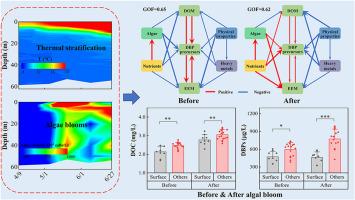溶解有机物和消毒副产物前体对深层水库藻类大量繁殖和热平流的响应。
IF 8.1
2区 环境科学与生态学
Q1 ENVIRONMENTAL SCIENCES
引用次数: 0
摘要
藻华会大量增加深层水库中的溶解有机物(DOM)和消毒副产物(DBP)前体,威胁饮用水安全。然而,藻华期间深水水库中 DOM 和 DBP 前体的变化情况仍不清楚。本文利用紫外光谱、荧光光谱和氯化实验分析了三河口水库藻华期间 DOM 和 DBP 前体物的变化。藻华发生前,DOM 和 DBP 前体物因生物降解而减少。藻类大量繁殖后,由于藻类产生类蛋白化合物,DOM 和 DBP 前体分别增加了 48.3% 和 86.9%。值得注意的是,藻华产生的一系列含氮化合物大大促进了三氯硝基甲烷的形成,而三氯硝基甲烷是造成与 DBPs 相关的哺乳动物细胞毒性的主要因素。此外,异质基质导致 DOM 和 DBP 前体分层。表层水(0-5 米)更容易受到藻类的影响,蛋白质类成分比其他层高得多,而腐殖质和富勒烯类成分则低得多。然而,高温和充足的氧气条件加速了 DOM 和 DBP 前体的生物降解,导致表层水中 DOM 和 DBP 前体的含量明显低于其它各层(p<0.05)。本文章由计算机程序翻译,如有差异,请以英文原文为准。

Response of dissolved organic matter and disinfection by-product precursors to algal blooms and thermal stratification in deep reservoirs
Algal bloom contribute substantially to dissolved organic matter (DOM) and disinfection by-product (DBP) precursors in deep reservoirs, threatening drinking water safety. However, the variations in DOM and DBP precursors in deep-water reservoirs during algal bloom remain unclear. UV and fluorescence spectroscopy and chlorination experiments were used to analyze the variations in DOM and DBP precursors during algal bloom in the Sanhekou Reservoir. Before algal bloom, the DOM and DBP precursors decreased due to biodegradation. After algal bloom, the DOM and DBP precursors increased by 48.3% and 86.9% due to algae producing protein-like compounds. Notably, the algal bloom produced a range of nitrogenous compounds that significantly promote the formation of trichloronitromethane, a major contributor to the mammalian cytotoxicity associated with DBPs. In addition, the heterogeneous matrix led to the stratification of DOM and DBP precursors. The surface water (0–5 m) was more vulnerable to algae, with protein-like components being much higher than in other layers, while humic and fulvic-like components were much lower. However, high temperatures and sufficient oxygen conditions accelerated the biodegradation of DOM and DBP precursors, resulting in significantly lower levels of DOM and DBP precursors in the surface water compared to other layers (p < 0.05). This study provides insights into the variations and the drivers in DOM and DBP precursors during algal bloom, essential for developing water intake strategies in similar water reservoirs.
求助全文
通过发布文献求助,成功后即可免费获取论文全文。
去求助
来源期刊

Chemosphere
环境科学-环境科学
CiteScore
15.80
自引率
8.00%
发文量
4975
审稿时长
3.4 months
期刊介绍:
Chemosphere, being an international multidisciplinary journal, is dedicated to publishing original communications and review articles on chemicals in the environment. The scope covers a wide range of topics, including the identification, quantification, behavior, fate, toxicology, treatment, and remediation of chemicals in the bio-, hydro-, litho-, and atmosphere, ensuring the broad dissemination of research in this field.
 求助内容:
求助内容: 应助结果提醒方式:
应助结果提醒方式:


